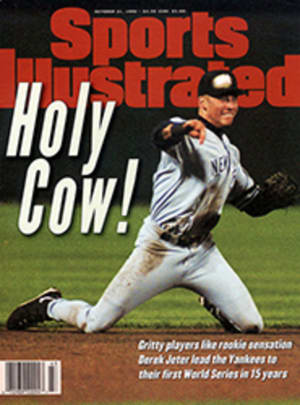
HERE'S LOOKING AT YOU, KID WHEN A 12-YEAR-OLD AFFECTS A PLAYOFF RESULT, IT'S TIME FOR BASEBALL TO GET INSTANT REPLAY
The VCR in major league baseball's office is blinking 12:00 ...
12:00 ... 12:00. Hey, guys, get with the times. For all
baseball's embarrassments in the daffy 1996 postseason, at least
one--the phony Derek Jeter home run in Game 1 of the American
League Championship Series--could have been avoided if someone
in the commissioner's office had had a clue about the outside
world. Instant replay, a bit of gadgetry even older than
Betamax, could have cleared up the Yankee Stadium mess in less
than a minute, but sadly, this horsehide-bound game is unwired.
Replay technology is so simple, a 12-year-old could explain it.
Even a 12-year-old who plays hooky. And we have a candidate:
Jeff Maier, who blew out of school last week with a note saying
he was going to the orthodontist and now is in his 16th minute
of fame as the New York Yankees' rightfield whiz kid. Master
October reached over the wall at Jeter's fly ball, which seemed
about to fall into the hands of Baltimore Orioles outfielder
Tony Tarasco, and tipped it into the stands for what mistakenly
was ruled a homer. NBC captured Jeff's misdemeanor on videotape
from innumerable angles--you wish surveillance cameras in
convenience stores worked so well--and while it wasn't exactly
the Zapruder film, the replays were shown so often that he got
on Good Morning, America and was invited to swap witticisms with
David Letterman. Unfortunately, one of the few people who didn't
have immediate access to the replay was rightfield umpire Rich
Garcia, who needed it the most.
Baseball has erred as grievously as Jose Offerman in not bending
technology to fit its pastoral game. If integrated judiciously,
instant replay would prevent injustices such as the one suffered
by the Orioles. Leave the calls on balls and strikes, balks and
plays at the bases in human hands. But even stiff-necked and
large-bellied umpires should admit the benefits of replays on
balls that may have been fair or foul, caught or trapped, or
interfered with by fans. There is no good reason that baseball
shouldn't barge into the 21st century even if it has skipped the
last two decades of the 20th. It's a game without time
restraints, so there would be no harm done if umps occasionally
took an extra two minutes to review videotape and get a call
right.
As NBC's replays of Maier's glovework demonstrated, at the very
least video review would short-circuit some on-field rhubarbs.
No other sport allows its players or managers/coaches so much
leeway in confronting authority, in dishing out--or in the age
of the argumentative ump, accepting--abuse. If baseball had an
immediate, electronic court of appeals for certain situations,
it would make the game a little more civil. Let a manager take
up his beef with a few feet of videotape. By reducing the
time-consuming, profane bickering that leaves fans spitting mad,
replays would be a welcome encroachment on baseball tradition.
The NHL, which once stood for Neanderthal Hockey League, has
been with the program for five years. In 1991-92 it began using
video replays to verify goals. The number of goals reviewed
increased from 133 in the first season of replay to 257 in
1995-96. And while it might seem as if replay has gone from
being a referee's tool to being his crutch, those 257 reviews
worked out to an average of one every four games. "Gee," one NHL
official said self-deprecatingly, "even we use replays."
Of course the pioneer in instant replay was the NFL, which used
it for six seasons until abandoning it after the 1991 season.
The NFL decided to kill instant replay for a highly complex
reason: 60 Minutes kept coming on late. The problem was not in
the concept but in the NFL's decision to allow officials to
replay everything except Jeff George's sideline tantrums and to
entrust the system to the last 50 men in America who have rotary
telephones. After spending the next four years like an ostrich
with its head in the sand instead of helping the zebras get it
right, the NFL tiptoed back to the future last summer. It used
instant replay in 10 preseason games, limiting the categories of
reviewable plays and limiting coaches to three challenges per
half. The results: 13 challenges (a far cry from the
approximately 570 reviews in 1991), three reversed calls and an
average time of two minutes and 18 seconds to address each
challenge. Upon further review, instant replay looked even
better than Mike Wallace and could be voted back by team owners
in time for the regular season next fall.
In basketball the NCAA allows replays for questions involving
shot clocks and scoring errors, and the NBA has kicked around
replay to judge buzzer-beating shots, although the league's
competition committee has been reluctant to get wired. But
replays seem certain to find a niche in the NBA, the most
progressive of leagues, which regularly sends representatives to
play in international tournaments and has developed worthy
initiatives, such as the Stay in School program.
Maybe Jeff Maier should be forced to attend.
COLOR ILLUSTRATION: EVANGELOS VIGLIS [Drawing of New York Yankees player holding up cameraman in baseball glove]

